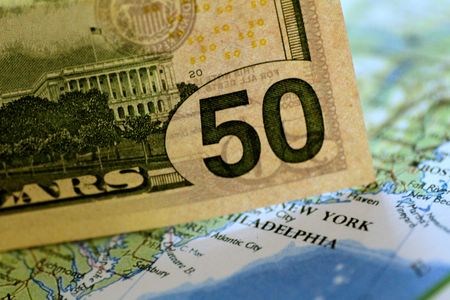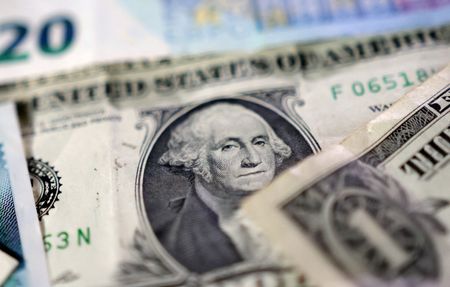By Kevin Buckland
TOKYO (Reuters) -The U.S. dollar edged up from its lowest level in close to a week on Wednesday, with traders expecting two more U.S. interest rate cuts this year, even after Federal Reserve Chair Jerome Powell struck a cautious tone on further easing overnight.
Australia’s dollar firmed after a hotter-than-expected headline reading of consumer inflation, less than a week before the Reserve Bank’s next policy decision. New Zealand’s dollar was steady following the naming of a new central bank chief.
The U.S. dollar index, which measures the currency against six major rivals, added 0.1% to 97.335 as of 0150 GMT, attempting to claw back some ground after two straight losing sessions that saw it touch the lowest since Thursday at 97.198 overnight.
Markets are priced for quarter-point rate cuts at each of the remaining two Fed policy meetings this year. Another reduction is expected in the first quarter of 2026, broadly aligning with forecasts from Fed officials following a quarter-point cut on Wednesday of last week.
The dollar had bounced back from the lowest level since early 2022 at 96.224 after the Fed’s policy announcement and Powell’s subsequent news conference, which fell short of the market’s more dovish expectations following a sharp weakening of the labor market.
On Tuesday, Powell said the central bank needs to continue balancing the competing risks of high inflation and a faltering job market in coming policy decisions, in comments that echoed those from last week. He called the policy dilemma “a challenging situation.”
“Powell’s overnight remarks underscored the central bank’s cautious approach,” said James Kniveton, senior corporate forex dealer at Convera.
“Powell acknowledged the absence of risk-free policy options, warning that premature easing could entrench inflation whilst excessive monetary restriction might unnecessarily damage employment prospects.”
The dollar added 0.1% to 147.77 yen.
The euro lost 0.1% to $1.1800.
Australia’s dollar gained 0.2% to $0.6613, reversing an earlier small loss, after the headline reading of the consumer price index (CPI) rose 3% in August compared to a year earlier, up from 2.8% in July and just above median forecasts of 2.9%.
However, the data picture was complicated by a key measure of core inflation easing back to 2.6%.
Traders slightly pared back bets for a rate cut by year-end to about 33%, according to LSEG data. Markets continue to expect no change to policy on September 30.
The New Zealand dollar was little changed at $0.5860.
New Zealand Finance Minister Nicola Willis on Wednesday announced that Swedish central banker Anna Breman has been appointed as the next Reserve Bank governor, making her the first woman in the role. She takes over from December 1.
(Reporting by Kevin Buckland; Editing by Sam Holmes and Lincoln Feast.)











